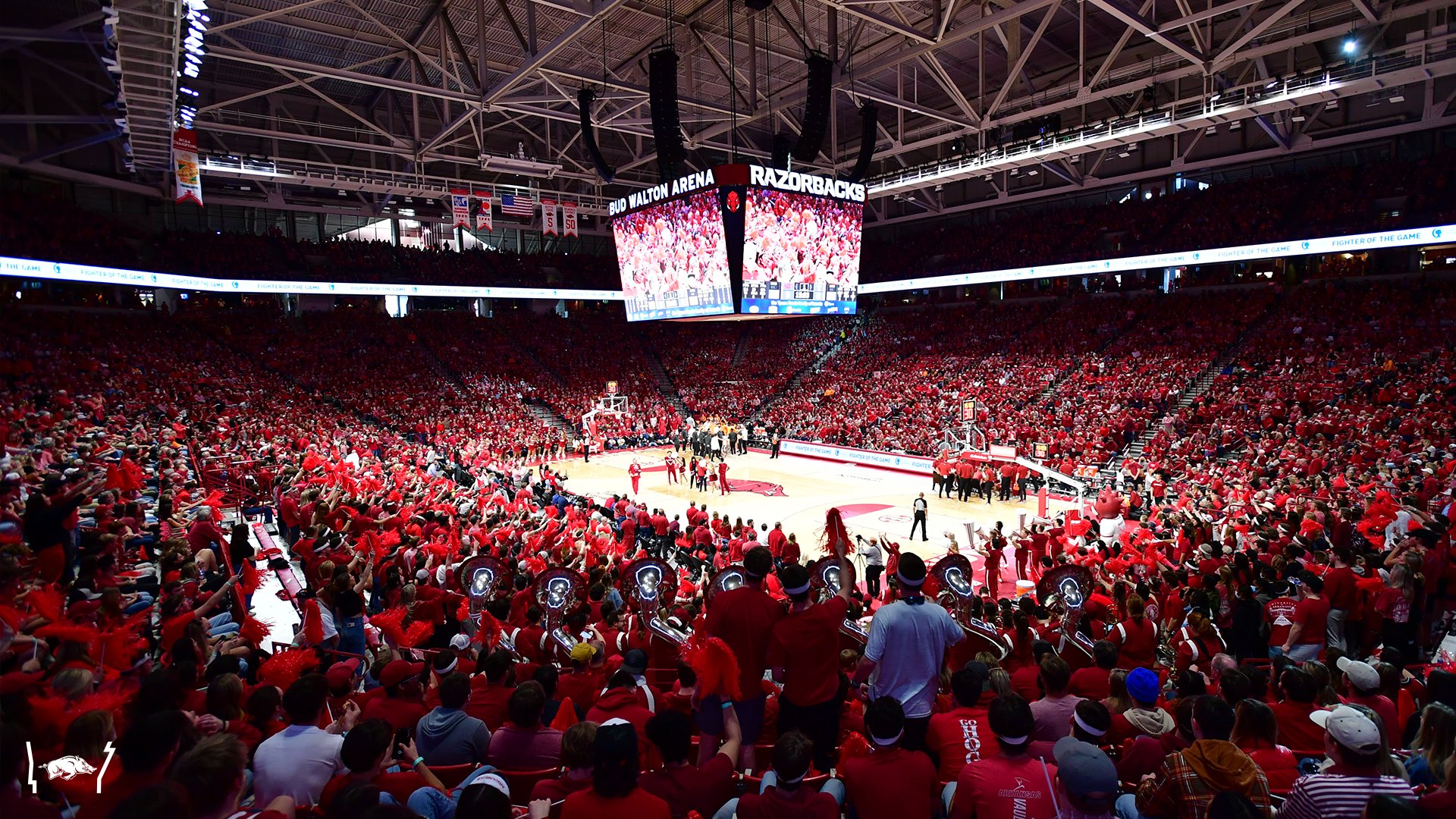If the Hogs want to make the SEC championship game for the first time since 2017, they’ll have to get through a familiar opponent. The Hogs split the regular season series with Texas A&M (22-11, 9-9), with each team winning a close game at home. The Aggies are trying to play their way into the NCAA Tournament, with Friday’s win over Auburn serving as their biggest statement yet.
Meet the Aggies
In a year full of weird seasons in the SEC, the Aggies have had a weird season. They played a very weak non-conference schedule, leading bracketologists to note that they probably needed to finish above .500 in the SEC to be in contention for an NCAA bid. After a 4-0 conference start that included an 86-81 win over the Hogs in College Station, they lost eight straight games and vanished from the radar. And yet, here they are, legitimately on the bubble, winners of six straight and seven of eight. Sure, some of it was the schedule easing up: the Aggies beat Georgia, Ole Miss, Florida (home), and Mississippi State (home) down the stretch in the regular season. But they also went on the road and beat Alabama and have beaten Florida and Auburn in consecutive days in Tampa.
Their recent success has not significantly moved the needle, as the advanced metrics think they’ve had some good luck during their hot streak (and had some bad luck during their 8-game losing streak):
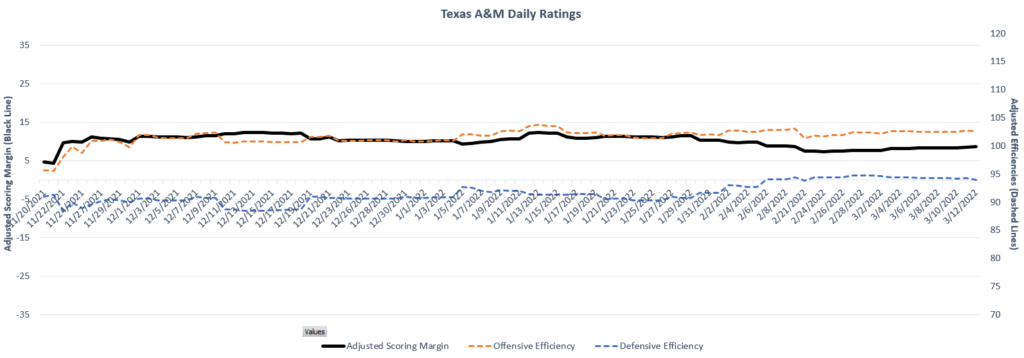
The Aggies’ Adjusted Scoring Margin bottomed out at +7.5 in late February and is +8.4 (Saturday edit: +8.6) today. So that’s modest improvement. Game score tells a better picture, of a decent team that had a couple really bad games becoming a decent team that’s had a couple really good games of late:
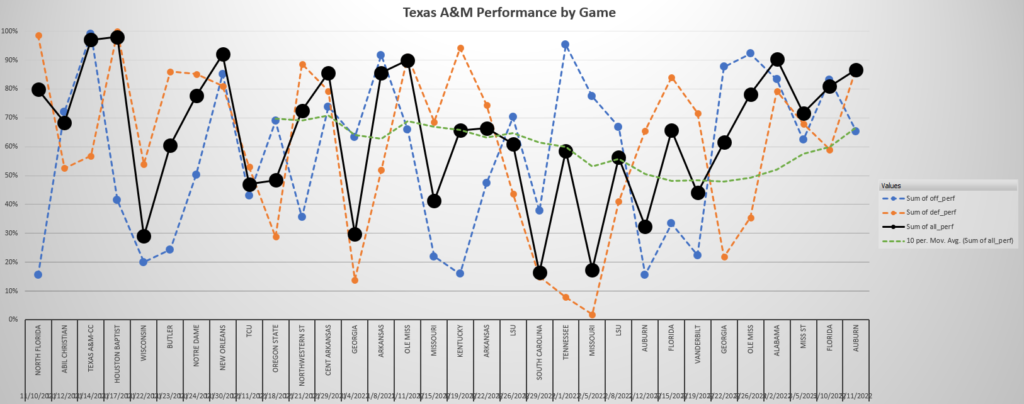
Their overall (black) grade of 90 against Alabama was their first 90+ score since the first Ole Miss game, which (not coincidentally) was the next-to-last game of their 4-0 SEC start.
As always, our two models make picks. The matchup model constructs a predicted box score based on team stats, while the traditional model uses each team’s adjusted efficiencies and adds a momentum factor.
- Traditional Model: Arkansas 74, Texas A&M 69
- Matchup Model: Arkansas 71, Texas A&M 70
The matchup model thinks this is a tough one for the Hogs. After all, the Razorbacks lost in College Station and needed overtime to win in Fayetteville, so maybe it’s onto something.
Team Profile

Texas A&M has relied on defense all season, with a recent surge in offense contributing to their success. Still, they are only up to 111th in Adjusted Offensive Efficiency, slightly behind LSU (108th) and without LSU’s defense on the other end. Their resume margin ranks 64th, which means they wouldn’t be on this model’s bubble.
Personnel Profile

Quenton Jackson has been a monster over the last few games, while Henry Coleman III has also been solid.
Both Arkansas and Texas A&M are similar on defense: great against guards, bad against forwards. That makes for an interesting matchup as the Jackson-versus-Notae narrative should probably be more of a Coleman-versus-Jaylin Williams narrative.
A&M’s defense ranks 3rd in the nation in game score against point guards, and the Ags are also top-100 against opposing shooting guards. JD Notae had 17 points on 6 of 21 shooting with 5 turnovers in the Fayetteville game that Arkansas won, though he had 31 points in College Station, the best performance by an opposing point guard against A&M all season. The Aggies just held Auburn’s KD Johnson to zero points on 0 of 14 shooting one day after holding Florida’s Tyree Appleby to zero points on 0 of 4 shooting. So yeah, smaller guards are the Aggies’ specialty.
But while the Aggies have to like the matchup with Notae, Arkansas likes the matchup with Jackson: the Hogs are 7th in the nation against shooting guards. They did their own thing to KD Johnson: 2 points on 1 of 7 shooting in February’s game.
But forwards are where the game will likely be decided. Both teams are outside the top 300 nationally in defense against power forwards. The Aggies are also bad against taller combo guards, so Stanley Umude, Au’Diese Toney, and Trey Wade also figure to get favorable looks.
When Texas A&M has the ball

Both teams play better when they push the pace, so expect the game to either be fast or ugly. The Aggies need to draw fouls and make 2-point shots. The fouls part might happen — Arkansas ranks just 207th at keeping opponents off the free throw line — but the 2-point shooting part is an issue, as Arkansas has basically had a top-10 defense against 2-point shooting for two months now. Additionally, the Aggies are occasionally turnover-prone, so the Hogs might can push that.
A&M won’t shoot a ton of 3-pointers — and they aren’t great at making them — so they do most of their dirty work near the rim, where they can get offensive rebounds and draw fouls. The guards can penetrate off the dribble, and Coleman is dangerous for traditional paint touches and also putbacks.
When Arkansas has the ball

The Hog offense against the A&M defense is where this game will be won or lost. I think the Hogs can contain Jackson and keep A&M from breaking out. But can Arkansas solve the Aggie defense?
On the stat side, you can see the A&M is somewhat similar to LSU in that they will trade fouling in order to force turnovers. The Hogs should be able to live at the free throw line but need to be careful of the Aggie pressure. But A&M really struggles to clear defensive rebounds. Auburn had 18 in the quarterfinals, for example.
The no-middle defense
Okay, it’s time for a scheme breakdown! Our breakdown of LSU’s pack line defense remains the most popular post on this site, so here’s hoping we can learn more about what Buzz Williams is doing together.
The no-middle defense originates in the NBA. When the NBA finally scaled back the archaic “illegal defense” rule in 2001 — which required defensive players to either guard the ball or guard their man, effectively banning zone and gap defenses — a bevy of new defensive schemes came on the scene. The end result was that defenses were able to take away the iso-heavy offenses that marked the era of Michael Jordan, Magic Johnson, and Larry Bird. But the result after that was that was that offenses figured out that 4- and 5-out spacing with quick ball reversals could create open 3-pointers that would render these defenses useless. Have you ever found yourself complaining about “what the NBA has become” with all the 3-pointers and no midrange shots? Blame the defenses that emerged in the wake of the end of the illegal defense era in the early 2000s.
Check out this incredible video from Hoop Vision for more. A lot of the examples on this article are covered here and it is my primary source:
The main principle that emerged in the early 2000s NBA was “icing” a ball screen. When you ice a screen, you force the ballhandler baseline, so he cannot use the screen. The theory is that offensive players are more dangerous in the middle of the floor and will use ball screens to get there.
Watch Notae’s defender “ice” this screen to prevent Notae from using it to get back to the middle of the floor:
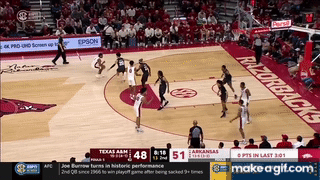
Icing screens is now common in all levels of basketball. But in 2016, the college basketball world was introduced to something new. A defense that took the philosophy of icing beyond ball screens and made “keep the ball out of the middle” the central tenet of its system. The no-middle defense. And the team that introduced it to the world on a shocking March day in 2016 was located right here in Arkansas:
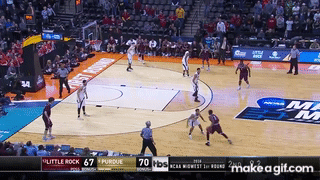
When journeyman coach Chris Beard teamed up with veteran assistant Mark Adams at Angelo State, the no-middle defense was born. Beard and Adams led the Little Rock Trojans to a 30-win season and stunning upset of Purdue in March Madness that truly came out of nowhere.
The pair then went to Texas Tech, where the no-middle defense made a run to the national title game. Beard and Adams have since split ways: Texas hired Beard but Texas Tech smartly kept Adams, the actual architect of the scheme. I’ve got the Red Raider defense ranked #4 in the country in Adjusted Defensive Efficiency this season.
Arkansas’ staff, then, is not unfamiliar with the no-middle. Watch the way the Red Raider defense tries the force the ball baseline, both with the on-ball defender and the one-pass-away defender (on Moses Moody):

That’s in line with the general idea of the no-middle: keep the ball out of the middle of the floor at all costs.
Here, the Aggie defense tries to force Notae into the side as soon as he crosses halfcourt by “shading” back to the middle of the floor:

There are a lot of similarities here to LSU’s pack line defense. Both are man-to-man schemes that aren’t purely man: defenders often play in the gaps between the ball and their man. In the pack line, the goal is to keep the ball way out on the perimeter. In the no-middle, it’s to keep it from moving to the middle. You see the same vulnerabilities: giving up offensive rebounds, for example. The Aggies struggle on the defensive glass because they are rarely in good box-out position when the shot goes up.
Arkansas will probably attack Texas A&M the same way they attacked LSU… which is also the same way they attacked Texas Tech’s no-middle in last year’s second round game. Defense doesn’t like the ball in the middle? Put a 6’10 guy who can handle the ball in the middle and dare the defense to do something about it:

Williams dished 4 assists in last year’s game against Texas Tech and had 3 in the win over the Aggies in January. The Hogs utilized him to reverse the ball (as shown above) and make low-post entry passes from the high post, something the no-middle never wants to allow. His size and skill handling the ball made it difficult for no-middle defenses to dislodge him from the high post, where Arkansas could run its offense effectively.
Like the pack line, the no-middle tends to give up open 3-point shots, which is why you don’t see it in the NBA. No-middle defenses are particularly vulnerable to the “skip” pass, which is a pass that “skips” the nearest offensive player and goes to the other side of the floor:
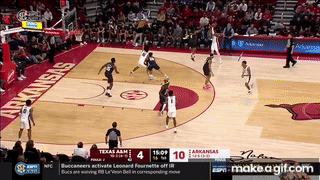
College teams have a harder time executing the catch-and-shoot 3 off a skip pass. Not only is the shooting percentage lower, the skip pass is difficult to execute. That’s why the Aggies are 5th in the nation in turnover rate:
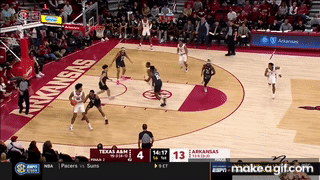
At the end of the day, Arkansas will probably attack A&M the same way the Hogs attacked LSU: use Williams at the top of the key and in the high post to repel A&M’s attempts to force the ball, crash the offensive glass due to the no-middle’s tendency to vacate the low post, and draw fouls when the Aggies try to be too aggressive.
Of course, there’s always the NBA strategy: extreme spacing. That’s why you don’t see these defenses at the next level. Quality spacing takes away a lot of what the no-middle is trying to do and opens up driving lanes (and offensive rebounding chances). Here, A&M is unable to prevent the ball moving back to the center of the floor:
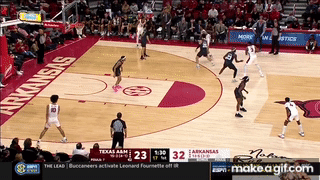
Note how A&M’s two low-post defenders have three assignments between them: the lane, Umude in the top corner, and Williams in the bottom corner. Good looks are available if you can find them.
Keys to the Game
- Williams the trigger man. As we just discussed, Williams is the key to attacking Texas A&M’s no-middle defense. The Aggies will have a difficult time keeping him out of the middle of the floor, where he can find open shooters and even put the ball on the floor himself. If he makes smart decisions with the ball, the Hogs should be golden.
- Avoid cheap fouls. The Aggies really need free throws to keep their offense moving. The Hogs have had some fouling issues in the past, so that can’t happen here.
- Clear the defensive rebounds. The Hogs just got a monster rebounding performance against LSU, but now here comes another team that wants to crash the offensive glass. Once again, the Hogs need Williams, but also Trey Wade, to win the battle on the boards. A&M will struggle if their offense doesn’t get second chances.
The latest from Fayette Villains, straight to your inbox
Enter your email to subscribe and receive new post alerts and other updates. You can unsubscribe at any time.
